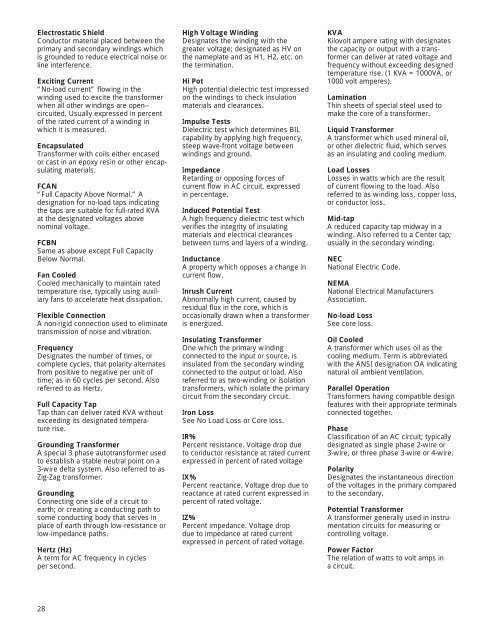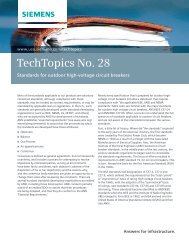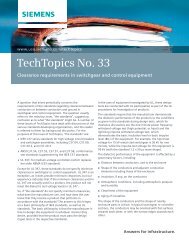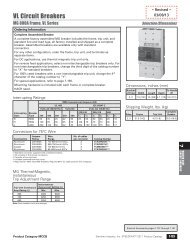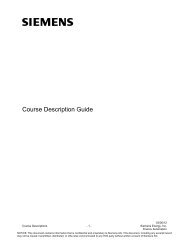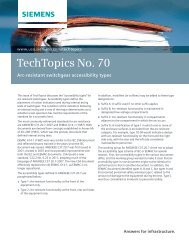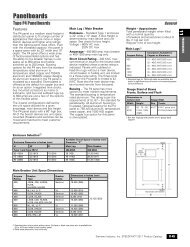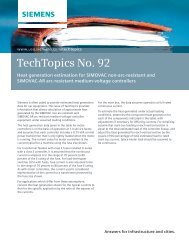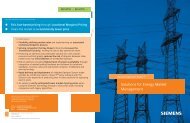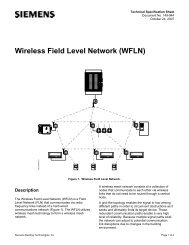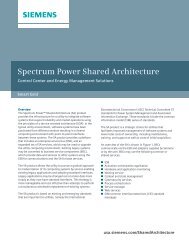Cover/Back.preflight (Page 2) - Siemens
Cover/Back.preflight (Page 2) - Siemens
Cover/Back.preflight (Page 2) - Siemens
You also want an ePaper? Increase the reach of your titles
YUMPU automatically turns print PDFs into web optimized ePapers that Google loves.
Electrostatic Shield<br />
Conductor material placed between the<br />
primary and secondary windings which<br />
is grounded to reduce electrical noise or<br />
line interference.<br />
Exciting Current<br />
“No-load current” flowing in the<br />
winding used to excite the transformer<br />
when all other windings are open--<br />
circuited. Usually expressed in percent<br />
of the rated current of a winding in<br />
which it is measured.<br />
Encapsulated<br />
Transformer with coils either encased<br />
or cast in an epoxy resin or other encapsulating<br />
materials.<br />
FCAN<br />
“Full Capacity Above Normal.” A<br />
designation for no-load taps indicating<br />
the taps are suitable for full-rated KVA<br />
at the designated voltages above<br />
nominal voltage.<br />
FCBN<br />
Same as above except Full Capacity<br />
Below Normal.<br />
Fan Cooled<br />
Cooled mechanically to maintain rated<br />
temperature rise, typically using auxiliary<br />
fans to accelerate heat dissipation.<br />
Flexible Connection<br />
A non-rigid connection used to eliminate<br />
transmission of noise and vibration.<br />
Frequency<br />
Designates the number of times, or<br />
complete cycles, that polarity alternates<br />
from positive to negative per unit of<br />
time; as in 60 cycles per second. Also<br />
referred to as Hertz.<br />
Full Capacity Tap<br />
Tap than can deliver rated KVA without<br />
exceeding its designated temperature<br />
rise.<br />
Grounding Transformer<br />
A special 3 phase autotransformer used<br />
to establish a stable neutral point on a<br />
3-wire delta system. Also referred to as<br />
Zig-Zag transformer.<br />
Grounding<br />
Connecting one side of a circuit to<br />
earth; or creating a conducting path to<br />
some conducting body that serves in<br />
place of earth through low-resistance or<br />
low-impedance paths.<br />
Hertz (Hz)<br />
A term for AC frequency in cycles<br />
per second.<br />
High Voltage Winding<br />
Designates the winding with the<br />
greater voltage; designated as HV on<br />
the nameplate and as H1, H2, etc. on<br />
the termination.<br />
Hi Pot<br />
High potential dielectric test impressed<br />
on the windings to check insulation<br />
materials and clearances.<br />
Impulse Tests<br />
Dielectric test which determines BIL<br />
capability by applying high frequency,<br />
steep wave-front voltage between<br />
windings and ground.<br />
Impedance<br />
Retarding or opposing forces of<br />
current flow in AC circuit, expressed<br />
in percentage.<br />
Induced Potential Test<br />
A high frequency dielectric test which<br />
verifies the integrity of insulating<br />
materials and electrical clearances<br />
between turns and layers of a winding.<br />
Inductance<br />
A property which opposes a change in<br />
current flow.<br />
Inrush Current<br />
Abnormally high current, caused by<br />
residual flux in the core, which is<br />
occasionally drawn when a transformer<br />
is energized.<br />
Insulating Transformer<br />
One which the primary winding<br />
connected to the input or source, is<br />
insulated from the secondary winding<br />
connected to the output or load. Also<br />
referred to as two-winding or isolation<br />
transformers, which isolate the primary<br />
circuit from the secondary circuit.<br />
Iron Loss<br />
See No Load Loss or Core loss.<br />
IR%<br />
Percent resistance. Voltage drop due<br />
to conductor resistance at rated current<br />
expressed in percent of rated voltage<br />
IX%<br />
Percent reactance. Voltage drop due to<br />
reactance at rated current expressed in<br />
percent of rated voltage.<br />
IZ%<br />
Percent impedance. Voltage drop<br />
due to impedance at rated current<br />
expressed in percent of rated voltage.<br />
KVA<br />
Kilovolt ampere rating with designates<br />
the capacity or output with a transformer<br />
can deliver at rated voltage and<br />
frequency without exceeding designed<br />
temperature rise. (1 KVA = 1000VA, or<br />
1000 volt amperes).<br />
Lamination<br />
Thin sheets of special steel used to<br />
make the core of a transformer.<br />
Liquid Transformer<br />
A transformer which used mineral oil,<br />
or other dielectric fluid, which serves<br />
as an insulating and cooling medium.<br />
Load Losses<br />
Losses in watts which are the result<br />
of current flowing to the load. Also<br />
referred to as winding loss, copper loss,<br />
or conductor loss.<br />
Mid-tap<br />
A reduced capacity tap midway in a<br />
winding. Also referred to a Center tap;<br />
usually in the secondary winding.<br />
NEC<br />
National Electric Code.<br />
NEMA<br />
National Electrical Manufacturers<br />
Association.<br />
No-load Loss<br />
See core loss.<br />
Oil Cooled<br />
A transformer which uses oil as the<br />
cooling medium. Term is abbreviated<br />
with the ANSI designation OA indicating<br />
natural oil ambient ventilation.<br />
Parallel Operation<br />
Transformers having compatible design<br />
features with their appropriate terminals<br />
connected together.<br />
Phase<br />
Classification of an AC circuit; typically<br />
designated as single phase 2-wire or<br />
3-wire, or three phase 3-wire or 4-wire.<br />
Polarity<br />
Designates the instantaneous direction<br />
of the voltages in the primary compared<br />
to the secondary.<br />
Potential Transformer<br />
A transformer generally used in instrumentation<br />
circuits for measuring or<br />
controlling voltage.<br />
Power Factor<br />
The relation of watts to volt amps in<br />
a circuit.<br />
28


